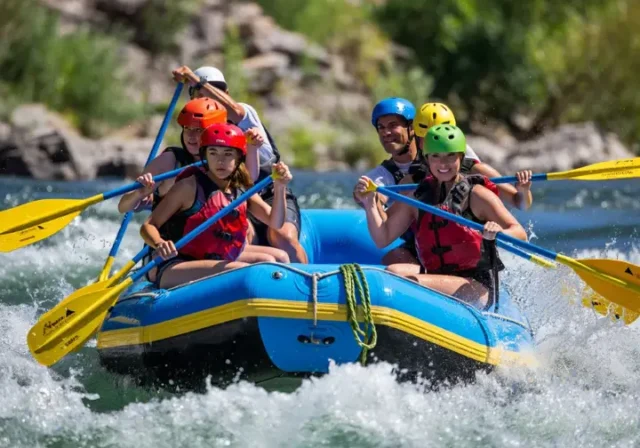In this article
Selecting a proper helmet for rafting is fundamental for safety and ensuring you can truly enjoy your whitewater experience. Respecting the river means using the right gear. Our guide delves into why helmets are essential, breaks down safety standards and components, explains how to get the perfect fit, and offers top recommendations for making an informed choice.
Ready to paddle with more confidence? Let’s explore how to find the helmet that keeps you safe while you conquer the rapids.
Why Whitewater Helmets Matter
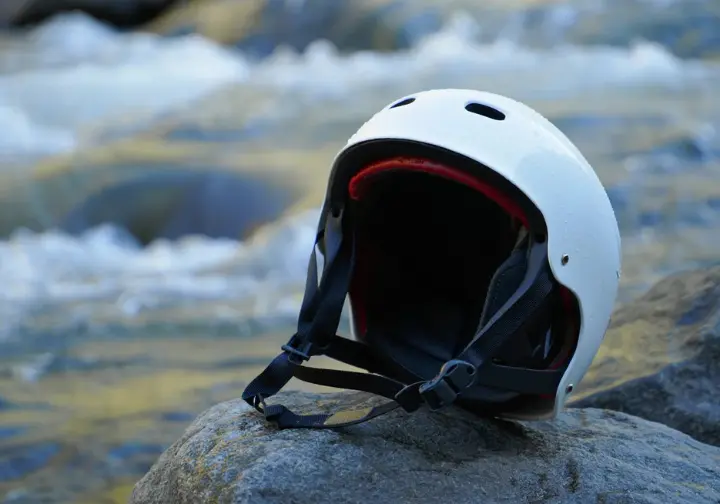
Understanding the necessity of a specialized whitewater helmet is the first step down the river of safety. It’s more than just headwear; it’s a critical piece of equipment designed for the unique challenges of a dynamic aquatic environment. Let’s break down why your choice matters so much.
Understanding River Hazards
The river environment is constantly changing, presenting impact risks from submerged rocks, logs, and even raft equipment like frames or paddles, especially during unexpected swims or turbulent moments. We once saw a fellow rafter take a minor tumble, only to have their helmet deflect a glancing blow from a paddle that could have easily caused a nasty gash. Head injuries, from cuts to more severe traumatic brain injuries (TBIs), are a real concern.
Wearing a properly fitted whitewater helmet isn’t just a suggestion; it’s non-negotiable safety. It’s your primary defense against the varied impacts you might encounter. Think of it as fundamental personal protective equipment, essential for responsible participation in the sport. The potential for serious head trauma underscores its importance.
You might wonder, why not use a bike or climbing helmet? There’s a specialized design need for whitewater. Helmets for other sports often use materials that degrade in water or are built for single, high-impact events, unlike the multiple, varied bumps common in rafting. Climbing helmets, focusing on top impacts, lack the comprehensive side protection needed on the river.
Whitewater helmet engineering addresses these specific needs. They are built to withstand multiple impacts from various directions and perform reliably when wet. Features like robust retention systems keep them secure in currents, and drainage holes prevent water buildup. Using the wrong type significantly compromises your safety.
Ultimately, protecting your head allows you to focus on enjoyment. Knowing you have the right safety gear enhances confidence and reduces anxiety about potential injuries. This mental freedom lets you fully engage with the thrill of the rapids, the teamwork involved, and the stunning natural beauty surrounding you. Doesn’t that sound like a better way to experience the river?
Decoding Safety Certifications
Navigating safety standards can feel like reading complex currents, but understanding them helps ensure your helmet meets essential protection levels. The primary standard to look for is CE EN 1385. This European certification signifies a helmet meets minimum requirements for impact absorption, retention system strength, coverage, and buoyancy after rigorous testing simulating whitewater forces.
It’s good to know the EN 1385 scope: it explicitly covers use in whitewater up to Class IV rapids. While many use these helmets in tougher Class V water, the standard itself doesn’t test for those extreme conditions. Performance beyond Class IV isn’t formally assessed by this specific certification.
For comparative data beyond pass/fail, look at the independent Virginia Tech STAR ratings. These assess a helmet’s ability to reduce linear and rotational acceleration during impacts, directly correlating to concussion risk. The lab tests multiple impacts at different locations and severities, offering a deeper insight into protective capabilities, as detailed in reports like the ACA’s coverage of the Virginia Tech study.
Understanding STAR scores is straightforward: lower scores indicate better performance in reducing concussion risk under their standardized tests (rated 1 to 5 stars). Remember, these are sport-specific; whitewater scores aren’t comparable to bike helmet ratings. The lab’s independence from manufacturers adds credibility.
You might also see MIPS technology, identifiable by a small yellow logo. This isn’t a standard but a safety feature. It uses a low-friction layer allowing slight movement between the shell and liner during angled impacts, aiming to reduce harmful rotational forces transferred to the brain.
Lastly, the ANSI Z89.1 relevance mainly applies to professional guides. OSHA regulations might require guides, as employees, to wear helmets meeting this industrial standard (focused on falling objects) if overhead impact risks exist. While its tests are rigorous, they target different primary hazards than EN 1385.
Anatomy of a Rafting Helmet
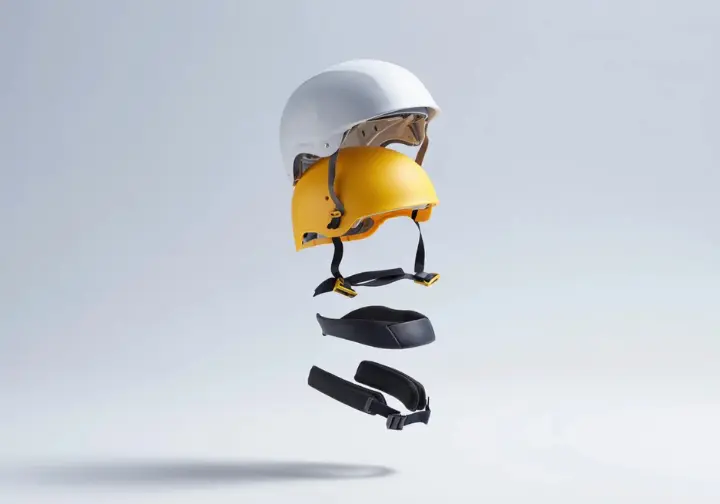
Like a well-designed raft, every part of a helmet serves a purpose. Understanding the shell, liner, retention system, and other features helps you appreciate how they work together to protect you. Let’s dissect the key components.
Shells and Liners
The helmet’s outer shell function is critical; it’s the first defense, distributing impact forces and resisting penetration from sharp objects like rocks. Common materials include durable ABS plastic (often in entry-level models) or lighter, stronger composites like carbon fiber or fiberglass found in premium helmets.
There are shell material trade-offs. ABS plastic is cost-effective and tough but heavier. Composites offer superior strength-to-weight ratios, enhancing comfort and potentially impact management, but cost more. Carbon shells might also show impact damage more clearly, signaling replacement needs.
Beneath the shell lies the impact-absorbing liner, usually foam. This is vital for cushioning impacts by compressing and slowing deceleration, absorbing harmful energy. Whitewater helmets typically use multi-impact foams like EPP (Expanded Polypropylene) or VN (Vinyl Nitrile), designed to handle multiple hits, unlike single-impact EPS foam found in bike helmets; you can explore detailed comparisons in resources like the Team River Runner Helmet Guide.
Exploring liner foam types, EPP is common for its multi-impact capability. EVA (Ethylene-Vinyl Acetate) is often used for comfort padding or in dual-density systems due to its durability and water resistance. Some high-end helmets use multi-density systems for better management of varying impact energies.
Sufficient liner thickness & fit are key for providing adequate stopping distance during impact. Internal comfort padding, often removable and washable, sits against the head, improving comfort and helping customize the fit. This combination ensures both safety and wearability.
Retention and Key Features
A helmet only works if it stays put. The retention system importance cannot be overstated; straps and adjustments keep the helmet securely positioned, especially during swims in turbulent water where forces try to pull it off. A helmet that shifts or comes off offers zero protection.
Key retention components include a snugly adjusted chin strap, Y-connectors below the ears for even tension, and a rear adjustment system (dial or harness) that cups the base of the skull (occipital bone) to prevent rocking. Some systems are designed to tighten under hydraulic pressure, enhancing security during swims.
Helmets come in different helmet coverage styles: Half-Cut (ears exposed, common, good ventilation/hearing), Full-Cut (covers ears, more protection/stability, warmer), and Full-Face (adds chin bar, maximum facial protection for extreme conditions). Your choice depends on the water type, preference, and desired protection level.
Drainage and ventilation are crucial. Holes or channels allow water to drain quickly, preventing the helmet from feeling heavy or being pulled by the current. They also provide airflow, keeping you cooler on warm days and improving comfort during exertion.
Some helmets feature visors and brims for sun protection and deflecting spray. While useful, poorly designed brims can catch water during swims, potentially causing the helmet to shift. Look for designs that mitigate this or offer removable visors.
Finally, consider color and visibility. While style is a factor, a brightly colored helmet significantly enhances visibility on the water. This is a critical safety element, making it easier for rescuers or partners to spot you if separated from the raft. High-visibility colors are strongly recommended.
Finding Your Perfect Fit
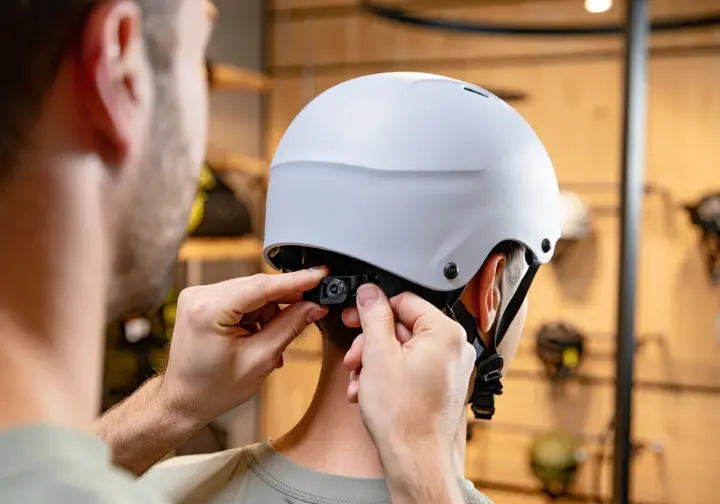
Even the best helmet is ineffective if it doesn’t fit correctly. Achieving a secure and comfortable fit is paramount for safety and ensures you’ll actually wear it. This involves accurate measurement, understanding head shape, and performing key fit tests.
Measuring and Head Shape
Start with accurate measurement. Use a flexible tape measure around the widest part of your head, about an inch above eyebrows and ears. Keep the tape level and note the measurement (cm or inches). Compare this to the specific manufacturer’s sizing chart, as sizes vary significantly between brands.
Beyond circumference, head shape matters. Most heads are generally oval (longer front-to-back) or round (more uniform). Helmets are often designed with a shape bias. A mismatch can cause uncomfortable pressure points, making extended wear difficult. How does your head shape influence your current gear choices?
Knowing brand shape tendencies can help. For example, some brands tend to fit oval heads better, while others often accommodate rounder shapes more comfortably. Trying helmets on, ideally at a local shop, remains the best way to find a match for your unique shape.
Consider oval head fit issues: putting an oval head in a round-fit helmet might cause pressure on the forehead and back. Conversely, a round head in an oval helmet might feel pressure on the sides. This highlights the importance of trying on helmets before buying; relying solely on measurements can be misleading.
Fit Tests and Adjustments
Begin with initial placement. Position the helmet level, the front rim sitting about one finger’s width above your eyebrows. It should feel snug all around without painful tightness or obvious gaps between the liner and your head.
Perform the Shake Test (or “Rockstar Test”). Before buckling, shake your head side-to-side and front-to-back. The helmet should move with your head, showing minimal independent wobble. Your skin should move with the internal liner, indicating a snug connection.
A crucial step is the forehead coverage check. Push up firmly on the front edge. The rear retention system should engage, preventing the helmet from tilting back and exposing your forehead. A common oversight is neglecting this test; a helmet failing it is unsafe.
Next, handle strap adjustment. Adjust the Y-connectors to meet comfortably just below your earlobes, ensuring even tension. Fasten and tighten the chin strap until snug – allowing maybe one or two fingers underneath, but not loose enough to slip over your chin.
Most helmets come with fine-tuning with fit kits – extra foam pads of varying thicknesses. Use these strategically (temples, forehead, back) to fill small gaps and eliminate minor movement for a customized fit. Don’t skip this step if the initial fit isn’t perfect.
Engage the rear adjusters (dial or harness) starting from fully loosened. Tighten until it securely cups the base of your skull without discomfort. This prevents rocking forward or backward, which is vital during dynamic river movements.
Wear the adjusted helmet for 5-10 minutes for a comfort check. Ensure no pressure points develop. A helmet that becomes uncomfortable during wear is less likely to be used consistently, undermining its purpose.
Top Helmet Recommendations
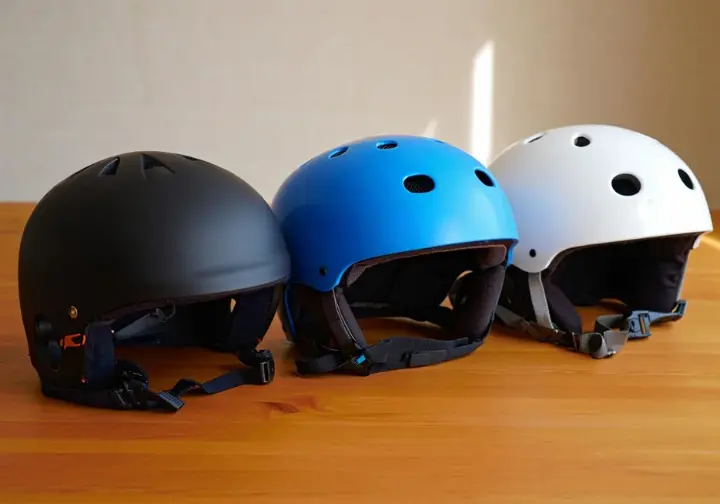
With the fundamentals covered, let’s look at some specific helmets often recommended by rafters. These selections consider budget, performance, fit characteristics, and specialized uses based on available information and common feedback.
Budget and All-Around Picks
NRS Chaos Full Cut | Affordable full-ear coverage with easy BOA fit
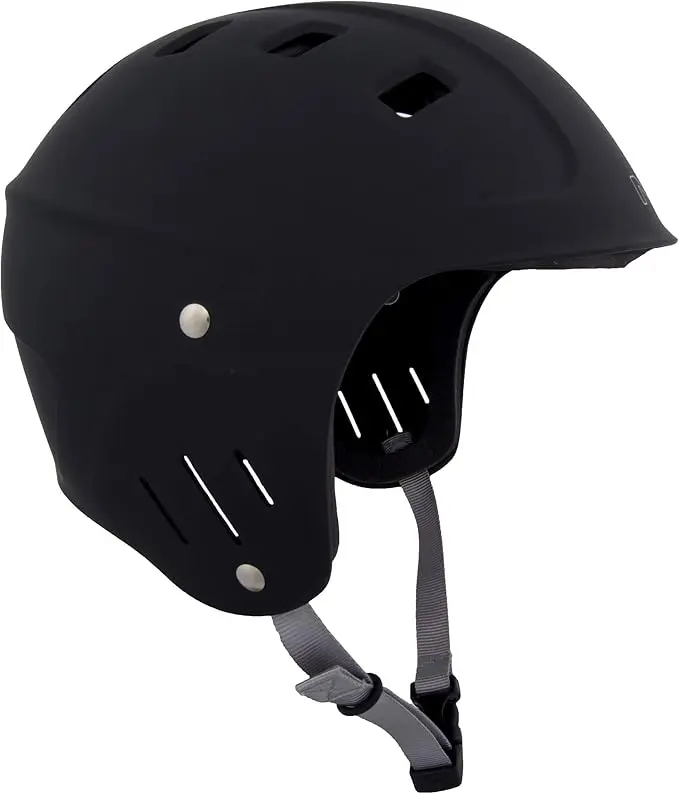
The NRS Chaos Full-Cut offers a solid entry point, balancing affordability with essential safety features. Its durable ABS plastic shell and dual-density EVA foam liner meet CE EN 1385 standards, providing reliable impact protection suitable for various whitewater activities. The full-cut design covers the ears, offering extra side protection without completely blocking sound, thanks to ventilation ports.
A key feature is the BOA dial-fit retention system, allowing for easy and precise adjustments to secure the helmet, even accommodating layers like neoprene hoods. While generally comfortable, some users note it runs small or specific pressure points can arise if overtightened. It’s a heavier option compared to composite helmets, but its ventilation helps manage heat.
This helmet represents a practical choice for those seeking dependable, full-coverage protection without a premium price tag. It’s well-suited for beginner to intermediate paddlers who prioritize ear protection and value the convenience of the BOA fit system.
PROS
- Affordable price point with CE EN 1385 certification.
- Easy and secure BOA dial-fit adjustment system.
- Full-cut design provides good ear protection.
- Adequate ventilation for comfort.
CONS
- Sizing tends to run small; trying on is recommended.
- Can feel heavier than composite models.
- Some users report minor fit discomfort (e.g., pressure points).
- Rivets may require rinsing after saltwater use.
Sweet Protection Wanderer II | Excellent safety/value, high VT score, fits oval heads
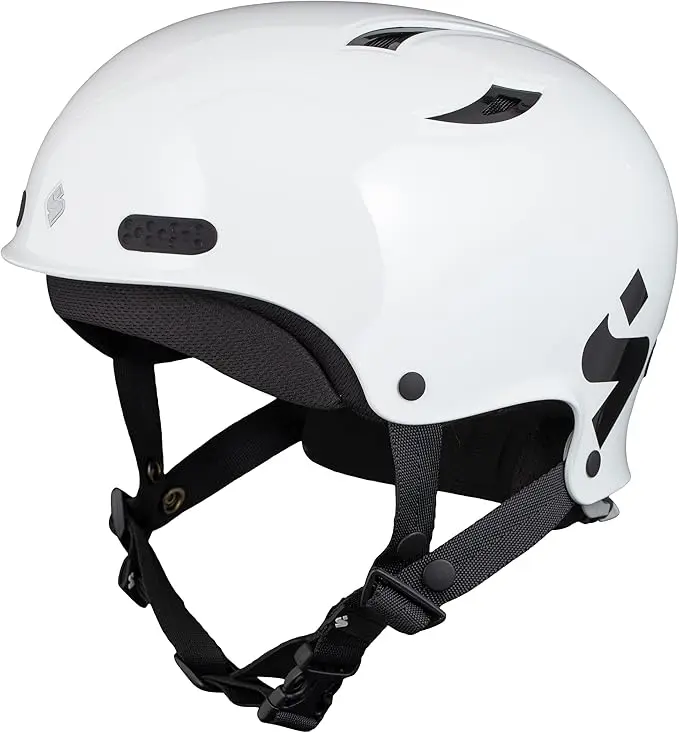
The Wanderer II strikes an excellent balance between performance, safety, and value. Its ABS shell, reinforced with carbon fiber, and multi-impact EPP liner provide robust protection, reflected in its CE EN 1385 certification and strong 3-star Virginia Tech STAR rating for concussion risk reduction. This makes it a dependable choice for various river conditions.
Its Occigrip tensioning system offers micro-adjustments for a secure, personalized fit, particularly favoring those with more oval-shaped heads. Combined with a lightweight design and effective ventilation through top ports and a Coolmax liner, it offers significant comfort for longer days on the water. It’s often praised for feeling almost unnoticeable once properly adjusted.
While it lacks ear pads (prioritizing hearing and weight), its overall safety profile and comfort make it a highly regarded all-around helmet. It’s a step up in protection and fit refinement from basic models, offering great bang for your buck.
PROS
- Excellent safety features (CE EN 1385, 3-star VT rating).
- Secure and comfortable Occigrip fit system, great for oval heads.
- Lightweight design enhances comfort.
- Good ventilation and moisture-wicking liner.
- Durable construction reported by users.
CONS
- Sizing can run slightly small for some.
- No ear pads included (may be a con for those wanting ear coverage).
- Occigrip dial can feel stiff initially.
- Ventilation might be limited in extreme heat.
Performance and Guide Choices
Sweet Protection Rocker | Top-tier protection (VT#1), secure fit for oval heads
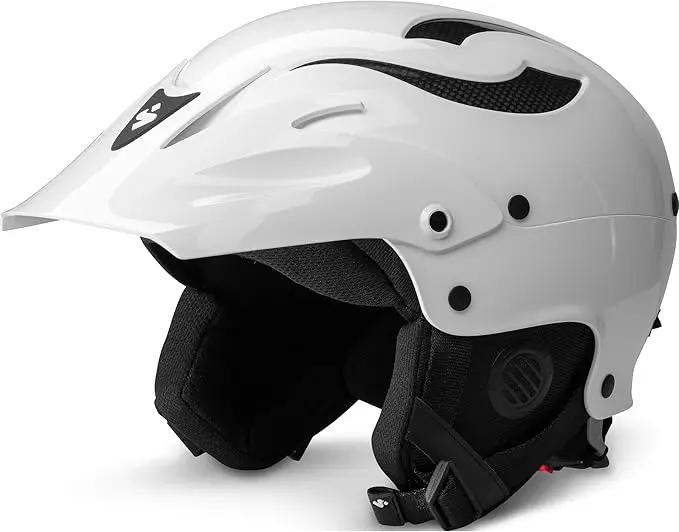
For those seeking premium protection, the Sweet Protection Rocker stands out, consistently ranking at the top in independent safety tests like the Virginia Tech Helmet Lab (#1 STAR score). Its advanced TLC (Thermoplastic Laminated Carbon Fiber) and ABS shell construction, paired with an EPP liner, offer exceptional impact resistance suitable for demanding whitewater conditions.
Like the Wanderer II, it features the Occigrip fit system, ensuring a secure and comfortable fit, especially for oval heads. It includes removable ear pads and an adjustable visor, adding versatility for different conditions and preferences. Despite its high protection level, it maintains a relatively low weight, contributing to comfort during long or challenging paddles.
The Rocker represents a top-tier investment for serious paddlers and guides who prioritize the highest level of certified protection and a refined fit. Its proven performance in rigorous testing provides significant peace of mind when navigating difficult rapids.
PROS
- Top-ranked protection (VT #1 STAR score, CE EN 1385, ASTM F1385).
- Secure Occigrip fit system, excellent for oval heads.
- Relatively lightweight despite high protection level.
- Includes removable ear pads and adjustable visor.
- Durable, high-quality construction.
CONS
- Premium price point.
- Sizing can run slightly small.
- Ear pads may detach or reduce hearing clarity for some users.
- Ventilation might be limited in extreme heat.
- Occigrip dial can be initially stiff.
WRSI Trident | Durable composite shell, comfortable secure fit for rounder heads
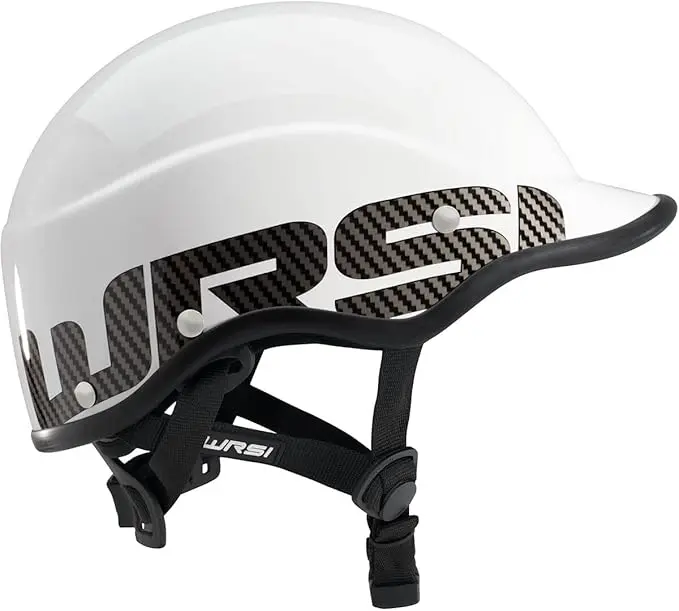
The WRSI Trident is another high-performance option, known for its durable carbon-composite shell and 3-Layer Impact Absorption System (including EVA foam and a polyurethane sub-shell). It meets CE EN 1385 standards and achieves a solid 3-star Virginia Tech STAR rating, offering reliable protection for challenging water.
Its standout feature is the Interconnect Retention System with an O-Brace harness, designed to self-adjust and remain secure during swims – a significant safety advantage. This system, combined with customizable fit pads, tends to provide a particularly comfortable and stable fit for those with rounder head shapes. A minimalist visor adds sun and splash protection.
While it lacks dedicated vents (which can make it warm in hot climates) and offers slightly less occipital coverage than some models, its robust construction and highly secure retention system make it a favorite among many experienced paddlers and guides.
PROS
- Durable carbon-composite shell and 3-layer impact system.
- Excellent Interconnect Retention System for secure fit, great for rounder heads.
- Comfortable, customizable fit with plush liner and pads.
- Meets CE EN 1385 and ASTM F1385, 3-star VT rating.
- Functional minimalist visor.
CONS
- No ventilation ports can lead to overheating in hot weather.
- Slightly heavier than some composite competitors.
- Limited occipital (back-of-head) coverage compared to some designs.
- Sizing can run small; trying on is recommended.
- Moderate to high price point.
Specialized Use Cases
Sweet Protection Strutter | Playboating choice for style and sun protection
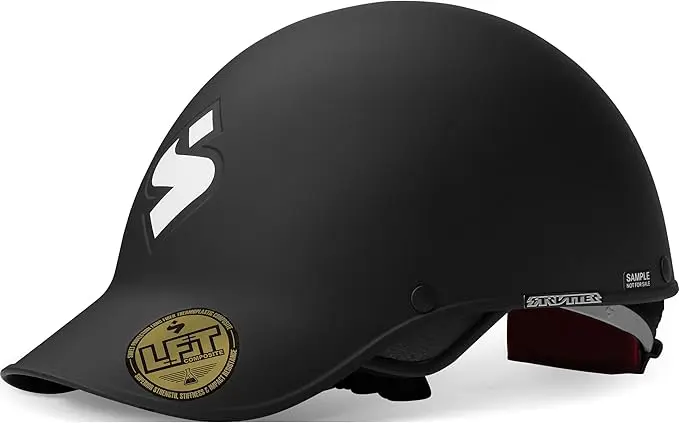
The Sweet Protection Strutter is an iconic helmet, particularly popular in the playboating scene, recognized for its distinctive low-volume, baseball cap-inspired design. Its LFT shell technology with carbon fiber reinforcement provides reliable protection (CE EN 1385 certified) for lower to medium-impact scenarios typical of playboating and river running.
The extended visor offers excellent sun and splash protection, a key reason for its popularity among guides and paddlers spending long hours on the water. It uses the Occigrip fit system, generally favoring oval heads, and maintains a very low weight for enhanced comfort. Its sleek profile minimizes interference during rolls and maneuvers.
However, its focus on style and low volume means it lacks ventilation and uses an EVA liner, making it less suitable for high-impact situations or very hot conditions compared to helmets like the Rocker. It’s an excellent choice for its specific niche but may not be the best all-around option for diverse whitewater rafting.
PROS
- Stylish, low-profile design with excellent sun/splash visor.
- Very lightweight and comfortable for extended wear.
- Secure Occigrip fit system, good for oval heads.
- CE EN 1385 certified for whitewater use.
- Durable construction for its intended use (playboating/river running).
CONS
- Narrow fit can cause pressure points, especially for rounder heads.
- No ventilation holes; can be hot in warm weather.
- EVA liner offers less high-impact protection than EPP.
- Sizing can run small or feel inconsistent for some.
- Not ideal for high-impact (Class IV+) whitewater.
Care and Final Thoughts
Investing in a quality helmet is just the first step; proper care ensures it continues to protect you effectively throughout its lifespan. Knowing when to retire your helmet is as important as choosing the right one initially.
Consider replacement triggers carefully. Any significant impact strong enough to cause dizziness or headache warrants replacement, even without visible damage, as the protective foam’s integrity could be compromised. Also, replace it if you see visible cracks, dents, or deformation in the shell or liner, or if straps and buckles are damaged.
Environmental factors also play a role. Prolonged UV exposure degrades materials, making shells brittle and weakening straps; significant fading is a warning sign. Age matters too; consider replacement every 5-10 years, or sooner with heavy use, due to gradual material degradation.
Practice regular care. Rinse your helmet with fresh water after each use to remove dirt and salt. Allow it to air dry completely away from direct sunlight. Store it in a cool, dry place, avoiding heavy objects on top, and perform visual inspections before trips.
Always prioritize fit. The best, most expensive helmet is useless if it doesn’t fit your head securely and comfortably while meeting safety standards like CE EN 1385. Take the time to try different models and use fit kits and adjustments diligently. What’s one fit adjustment you’ll double-check next time?
Ultimately, paddle confidently. Investing in the right helmet, understanding its features, ensuring a proper fit, and maintaining it allows you to focus on the adventure. Make informed choices, prioritize your safety, and fully embrace the excitement of the river.
Frequently Asked Questions
Why can’t I use my bike helmet for rafting? >
What does the CE EN 1385 certification mean? >
How do I know if my helmet fits correctly? >
How often should I replace my rafting helmet? >
We are a participant in the Amazon Services LLC Associates Program, an affiliate advertising program designed to provide a means for sites to earn advertising fees by advertising and linking to Amazon.com. As an Amazon Associate I earn from qualifying purchases. We also participate in other affiliate programs. The information provided on this website is provided for entertainment purposes only. We make no representations or warranties of any kind, expressed or implied, about the completeness, accuracy, adequacy, legality, usefulness, reliability, suitability, or availability of the information, or about anything else. Any reliance you place on the information is therefore strictly at your own risk. Additional terms are found in the terms of service.


